Effect of Preload on Box-Section Steel Columns Filled with Concrete under Axial Load: A Numerical Study
Abstract
:1. Introduction
2. Existing Models
3. Finite Element Model Study
3.1. Concrete Modeling and Properties
- fel = the stress at the elastic strain (εel) in the elastic range.
- εo = the strain at the ultimate cylinder compressive strength.
- f = the stress at any strain ε.
3.2. Steel Column Modeling and Characteristics
3.3. Model Studies of Structure
3.4. Choosing the Optimal Mesh Convergence
4. Verify the FEM Results and Existing Codes with Experimental Tests
4.1. Verify the FEM Results
4.2. Verify the Existing Code Results
5. Results and Discussion
5.1. The Behavior of Applied Load and Axial Shortening
5.2. The Effect of Variables and the Preload Ratio on the Efficiency of Columns
5.2.1. Effect of Column Cross-Section Dimensions

5.2.2. Effect of Column Height
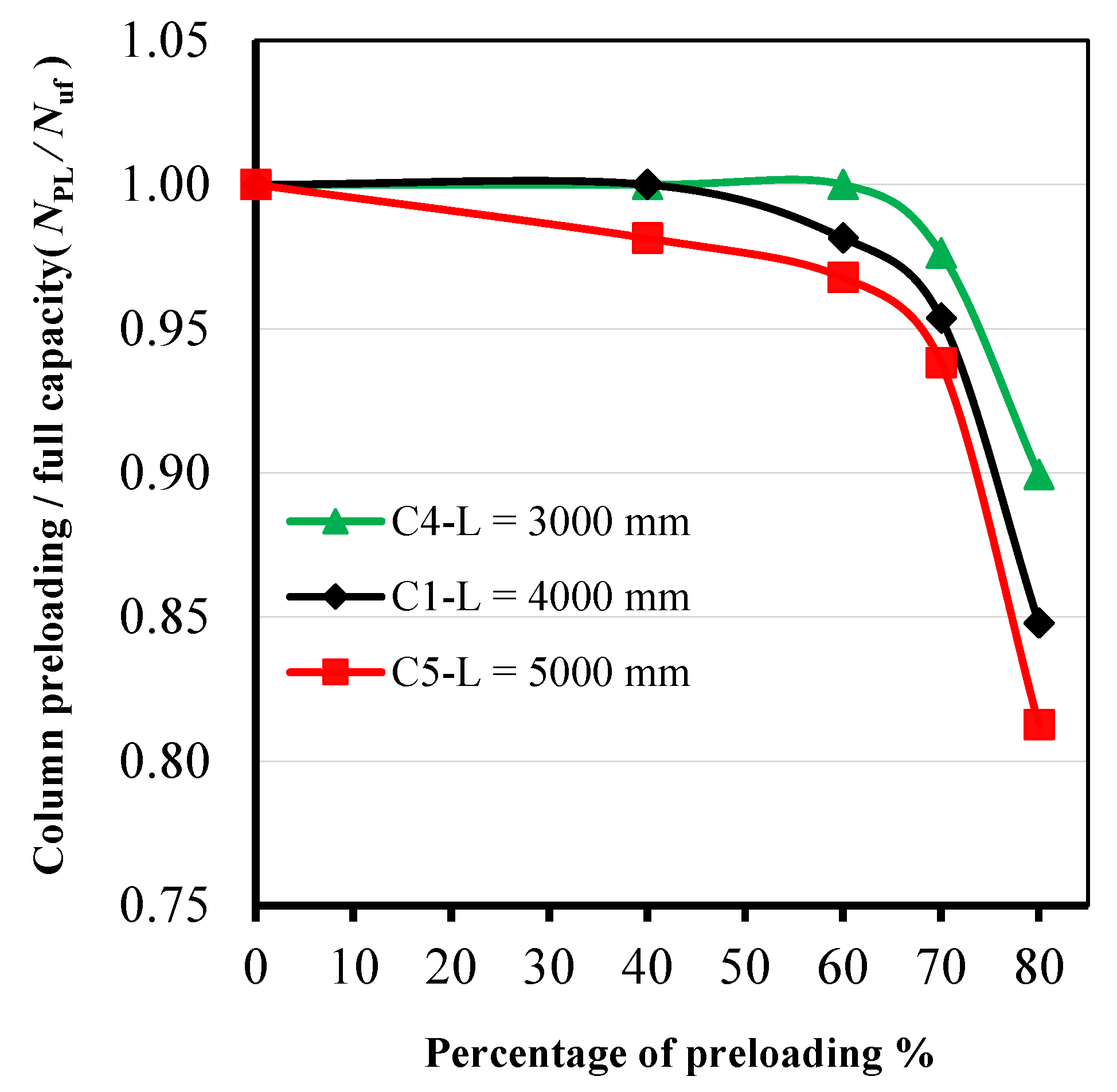
5.2.3. Effect of Column Wall Thickness
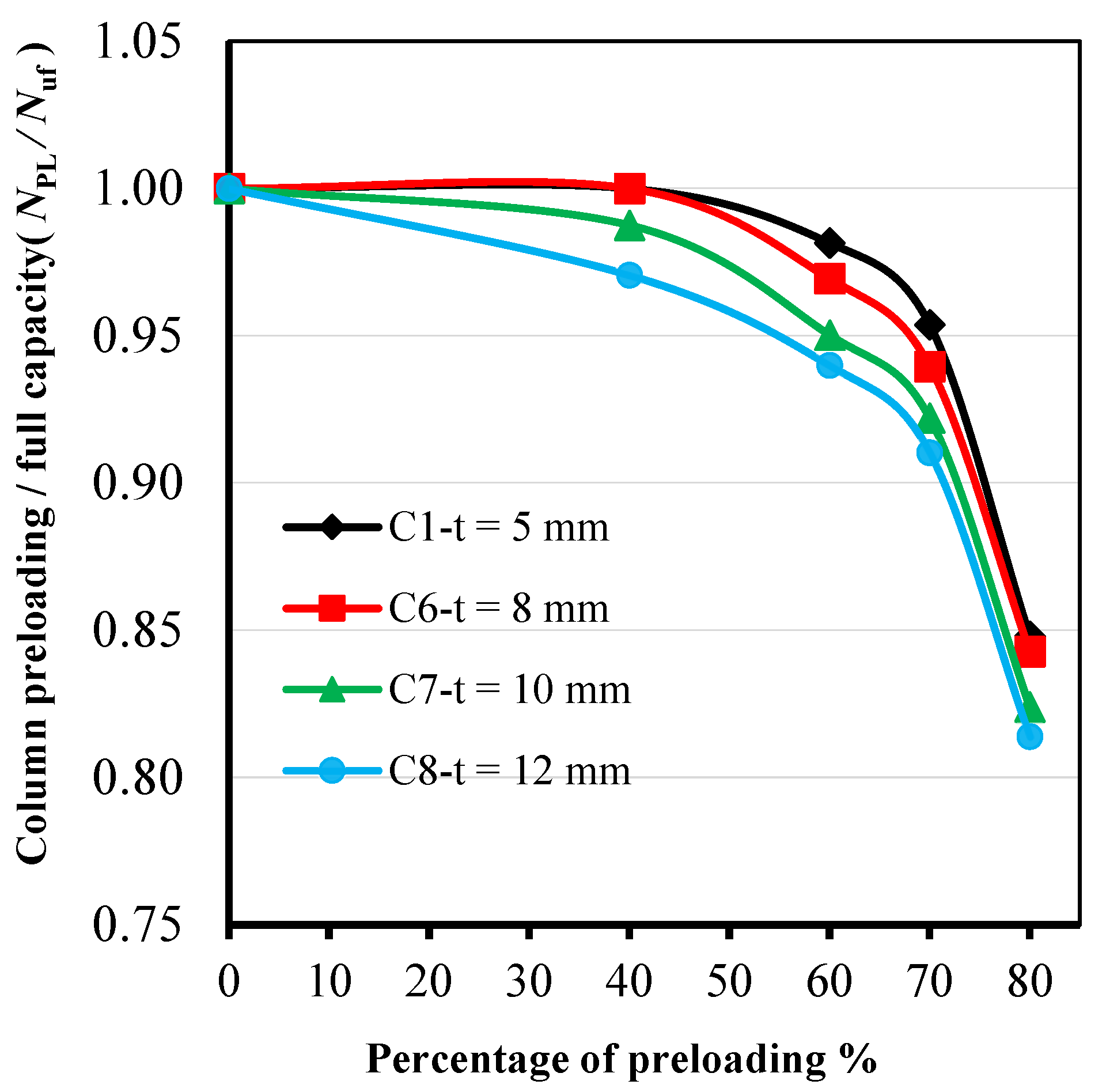
5.2.4. Effect of Concrete Strength
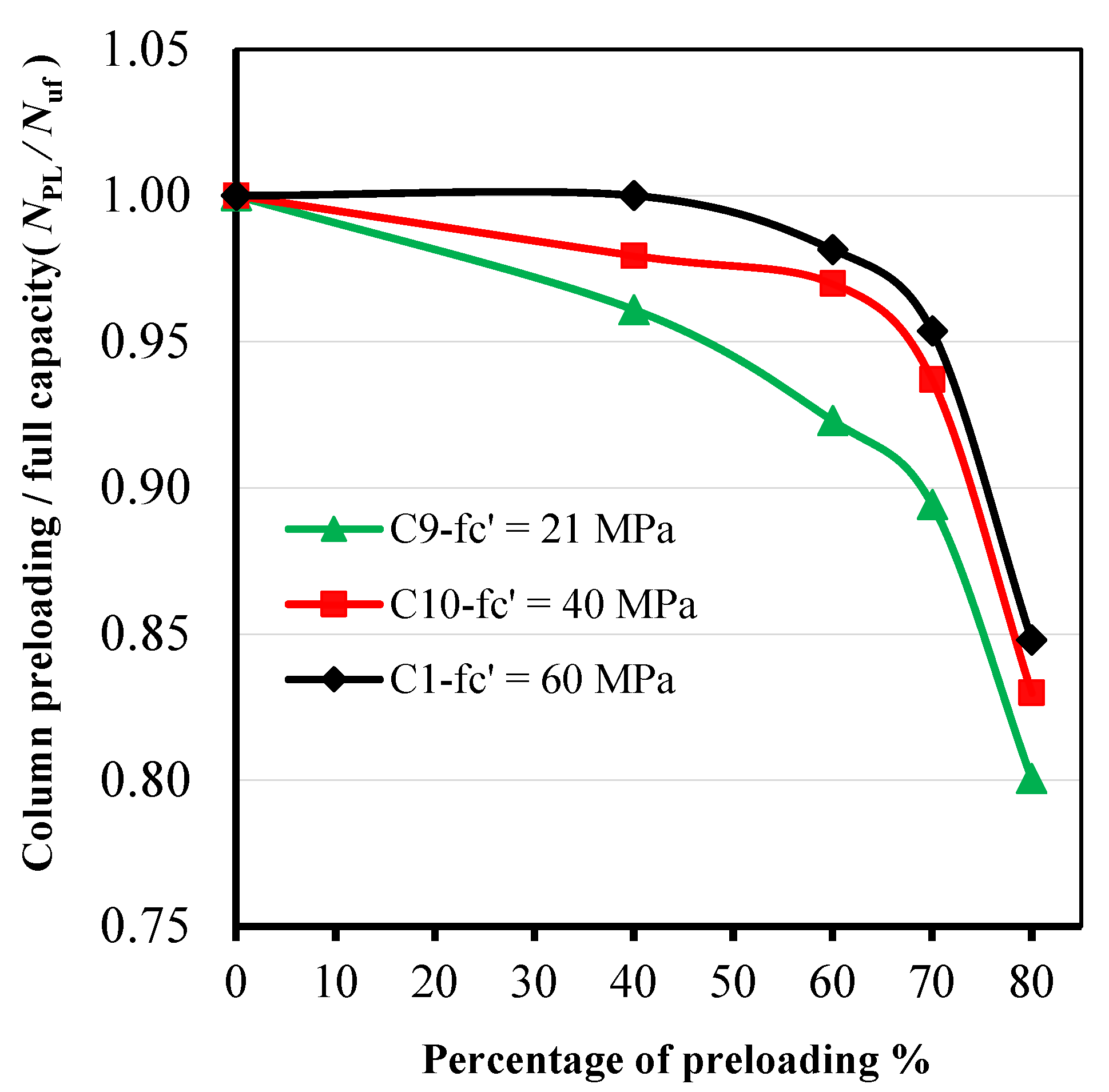
5.2.5. Effect of Steel Column Yield Stress
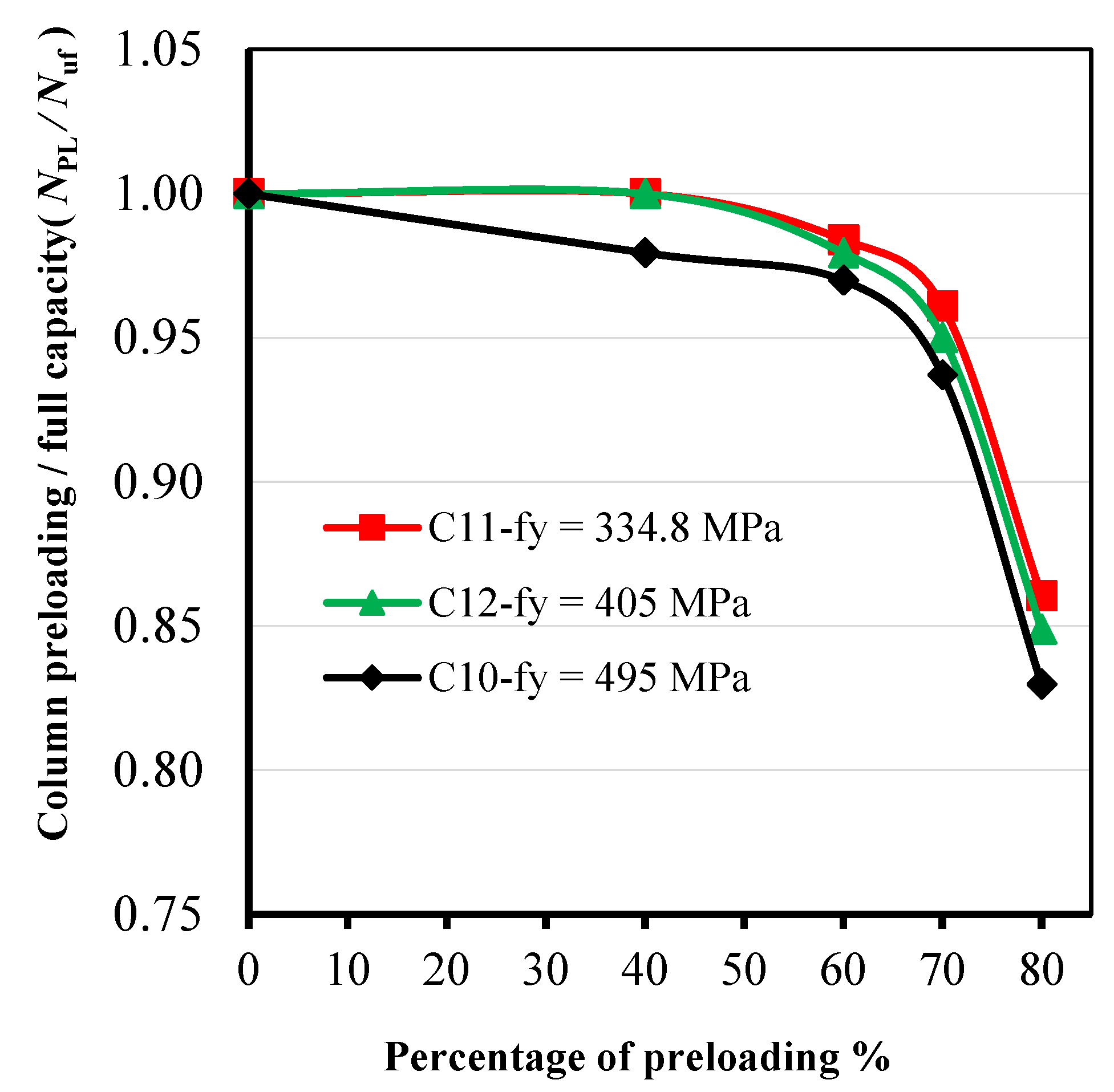
6. Prediction of Ultimate Axial Load Capacity under Preload
7. Conclusions
- For steel columns without concrete filling, prediction values calculated from existing codes, ANSI/AISC 360-22 and Eurocode-4, were always less than the actual ultimate capacity, average ratio is 0.951, whether resulting from experimental or FEM tests. This is a result of the existing codes relying only on the elastic region of the steel, while the behavior of the columns uses the actual properties of the available steel, as it enters the elastic–plastic region;
- Through the behavior of columns under preload, some variables are directly proportional to the value of the decrease in column capacity, in terms of column height, column wall thickness, yield stress, and preload ratios, while others are inversely proportional, in terms of cross-section dimensions and concrete strength;
- With some limits in the values of the geometric properties of steel columns and with preload ratios up to 60%, they do not affect the ultimate capacity of CFSC;
- In the case of a preload ratio not exceeding 70%, the value of the decrease in column capacity is approximately linear, and in small values, where the largest decrease ratio was equal to 0.891;
- With a preload ratio equal to 80%, there is a significant decrease in the percentage of remaining capacity of the columns reaching 0.801. This obviously affects the contribution of concrete, as the decreased value reaches 0.234;
- The proposed new models, Equations (23) and (24), using the ANSI/AISC 360-22 models, can predict the ultimate capacity of the axial load of CFSC under preloading. These models have appropriate accuracy, with r of 0.949 and 0.989 for preload ratios not exceeding 70% and equal to 80%, respectively.
Funding
Data Availability Statement
Acknowledgments
Conflicts of Interest
References
- ANSI/AISC 360-22; Specification for Structural Steel Buildings. American Institute of Steel Construction: Chicago, IL, USA, 2022.
- EN 1994-1-1: 2004; Design of Composite Steel and Concrete Structures, Part 1.1 General Rules and Rules for Buildings. European Committee for Standardization: Brussels, Belgium, 2004.
- Liu, J.; Gao, P.; Lin, X.; Wang, X.; Zhou, X.; Chen, Y.F. Experimental assessment on the size effects of circular concrete-filled steel tubular columns under axial compression. Eng. Struct. 2023, 275 Pt A, 115247. [Google Scholar] [CrossRef]
- Lei, M.; Li, Y.-L.; Li, Y.-Q.; Zhang, J.; Liu, D. Behavior of concrete-filled T-shaped steel tubular beam-columns under biaxial compressive loads. Eng. Struct. 2023, 277, 115409. [Google Scholar] [CrossRef]
- Wang, J.; Yang, Z.-M.; Zheng, X.-L.; Ding, Y. Axial compression behavior of square section concrete-filled steel tubes reinforced with internal latticed steel angles. J. Constr. Steel Res. 2024, 213, 108414. [Google Scholar] [CrossRef]
- Yang, Z.Y.; Liu, M.; Sun, L.; Shen, M.S. Size effect of axial compressive bearing capacity of high-strength concrete filled high-strength square steel tubular short columns. Structures 2024, 60, 105978. [Google Scholar] [CrossRef]
- Wang, Y.-B.; Song, C.; Xiong, M.-X.; Liew, J.Y.R. Mechanical behavior and design applicability of ultra-high-performance concrete-filled circular steel tubular short columns under axial compression. Eng. Struct. 2024, 299, 117112. [Google Scholar] [CrossRef]
- Hu, H.-S.; Yang, Z.-J.; Xu, L.; Zhang, Y.-X.; Gao, Y.-C. Axial compressive behavior of square concrete-filled steel tube columns with high-strength steel fiber-reinforced concrete. Eng. Struct. 2023, 285, 116047. [Google Scholar] [CrossRef]
- Schneider, S.P. Axially loaded concrete-filled steel tubes. J. Struct. Eng. 1998, 124, 1125–1138. [Google Scholar] [CrossRef]
- Uy, B. Strength of short concrete filled high strength steel box columns. J. Construct. Steel Res. 2001, 57, 113–134. [Google Scholar] [CrossRef]
- Han, L.-H. Tests on stub columns of concrete-filled RHS sections. J. Construct. Steel Res. 2002, 58, 353–372. [Google Scholar] [CrossRef]
- Dundu, M. Column buckling tests of hot-rolled concrete filled square hollow sections of mild to high strength steel. Eng. Struct. 2016, 127, 73–85. [Google Scholar] [CrossRef]
- Shakir-Khalil, H.; Mouli, M. Further tests on concrete-filled rectangular hollow-section columns. J. Struct. Eng. 1990, 68, 405–413. [Google Scholar]
- Zhu, A.; Zhang, X.; Zhu, H.; Zhu, J.; Lu, Y. Experimental study of concrete filled cold-formed steel tubular stub columns. J. Constr. Steel Res. 2017, 134, 17–27. [Google Scholar] [CrossRef]
- Tao, Z.; Han, L.H.; Wang, Z.B. Experimental behaviour of stiffened concrete-filled thin-walled hollow steel structural (HSS) stub columns. J. Constr. Steel Res. 2005, 61, 962–983. [Google Scholar] [CrossRef]
- Tao, Z.; Han, L.H.; Wang, D.Y. Strength and ductility of stiffened thin-walled hollow steel structural stub columns filled with concrete. Thin Walled Struct. 2008, 46, 1113–1128. [Google Scholar] [CrossRef]
- Tao, Z.; Uy, B.; Han, L.H.; Wang, Z.B. Analysis and design of concrete-filled stiffened thin-walled steel tubular columns under axial compression. Thin Walled Struct. 2009, 47, 1544–1556. [Google Scholar] [CrossRef]
- Liu, Y.J.; Zhang, J.G.; Xu, K.L.; Yao, W. Experimental research on stub columns of concrete filled steel box with longitudinal stiffener under axial load. J. Build. Struct. 2011, 32, 159–165. [Google Scholar]
- Liu, Y.J.; Cheng, G.; Zhang, N.; Zhang, J. Experimental research on concrete-filled square steel tubular columns stiffened with PBL. J. Build. Struct. 2014, 35, 39–46. [Google Scholar]
- Zhu, W.; Wang, J.; Liu, Y.; Sun, L. Experimental study on axial compressive behavior of concrete-filled double-skin thin-walled steel box columns with and without PBL. Structures 2023, 47, 1927–1939. [Google Scholar] [CrossRef]
- Yuan, W.-b.; Yang, J.-j. Experimental and numerical studies of short concrete-filled double skin composite tube columns under axially compressive loads. J. Constr. Steel Res. 2013, 80, 23–31. [Google Scholar] [CrossRef]
- Chen, J.; Ni, Y.-Y.; Jin, W.-l. Column tests of dodecagonal section double skin concrete-filled steel tubes. Thin Walled Struct. 2015, 88, 28–40. [Google Scholar] [CrossRef]
- Liang, W.; Dong, J.; Wang, Q. Mechanical behaviour of concrete-filled double-skin steel tube (CFDST) with stiffeners under axial and eccentric loading. Thin Walled Struct. 2019, 138, 215–230. [Google Scholar] [CrossRef]
- Qiao, Q.; Ding, R.; Cao, W. Experimental investigation on axial local compressive behavior of square concrete-filled double tubular stub columns. Structures 2023, 55, 2157–2174. [Google Scholar] [CrossRef]
- Hassanein, M.F.; Elchalakani, M.; Karrech, A.; Patel, V.I.; Yang, B. Behaviour of concrete-filled double-skin short columns under compression through finite element modelling: SHS outer and SHS inner tubes. Structures 2018, 14, 358–375. [Google Scholar] [CrossRef]
- Ding, F.-x.; Wang, W.-j.; Lu, D.-r.; Liu, X.-m. Study on the behavior of concrete-filled square double-skin steel tubular stub columns under axial loading. Structures 2020, 23, 665–676. [Google Scholar] [CrossRef]
- Ayough, P.; Sulong, N.H.R.; Ibrahim, Z.; Hsiao, P.-C. Nonlinear analysis of square concrete-filled double-skin steel tubular columns under axial compression. Eng. Struct. 2020, 216, 110678. [Google Scholar] [CrossRef]
- Zhang, Y.C.; Chen, Y. Experimental study and finite element analysis of square stub columns with straight ribs of concrete-filled thin-walled steel tube. J. Build. Struct. 2006, 27, 16–22. [Google Scholar]
- Zhang, Y.C.; Xu, C.; Lu, X.Z. Experimental study of hysteretic behaviour for concrete filled square thin-walled steel tubular columns. J. Constr. Steel Res. 2007, 63, 317–325. [Google Scholar] [CrossRef]
- Varma, A.H.; Ricles, J.M.; Sause, R.; Lu, L.-W. Experimental behaviour of high strength square concrete-filled steel tube beam-columns. J. Struct. Eng. 2002, 128, 309–318. [Google Scholar] [CrossRef]
- Liu, D.; Gho, W.-M.; Yuan, J. Ultimate capacity of high-strength rectangular concrete-filled steel hollow section stub columns. J. Constr. Steel Res. 2003, 59, 1499–1515. [Google Scholar] [CrossRef]
- Gho, W.-M.; Liu, D. Flexural behaviour of high-strength rectangular concrete-filled steel hollow sections. J. Construct. Steel Res. 2004, 60, 1681–1696. [Google Scholar] [CrossRef]
- Li, G.-C.; Chen, B.-W.; Zhu, B.-W.; Yang, Z.-J.; Ge, H.-B.; Liu, Y.-P. Axially loaded square concrete-filled steel tubular long columns made of high-strength materials: Experimental investigation, analytical behavior and design. J. Build. Eng. 2022, 58, 104994. [Google Scholar] [CrossRef]
- Guo, L.H.; Wang, Y.Y.; Zhang, S.M. Experimental study of concrete-filled rectangular HSS columns subjected to biaxial bending. Adv. Struct. Eng. 2012, 15, 1329–1344. [Google Scholar] [CrossRef]
- Kilpatrick, A.E.; Rangan, B.V. Tests on high-strength concrete-filled steel tubular columns. ACI Struct. J. 1999, 96, 268–275. [Google Scholar]
- Liu, D. Tests on high-strength rectangular concrete-filled steel hollow section stub columns. J. Construct. Steel Res. 2005, 61, 902–911. [Google Scholar] [CrossRef]
- Sakino, K.; Nakahara, H.; Morino, S.; Nishiyama, I. Behaviour of centrally loaded concrete-filled steel-tube short columns. J. Struct. Eng. 2004, 130, 180–188. [Google Scholar] [CrossRef]
- Young, B.; Ellobody, E. Experimental investigation of concrete-filled cold-formed high strength stainless steel tube columns. J. Constr. Steel Res. 2006, 62, 484–492. [Google Scholar] [CrossRef]
- Young, B.; Liu, Y. Experimental investigation of cold-formed stainless steel columns. J. Struct. Eng. 2003, 129, 169–176. [Google Scholar] [CrossRef]
- Zeghichea, J.; Chaoui, K. An experimental behaviour of concrete-filled steel tubular columns. J. Construct. Steel Res. 2005, 61, 53–66. [Google Scholar] [CrossRef]
- Pavlovčič, L.; Froschmeier, B.; Kuhlmann, U.; Beg, D. Finite element simulation of slender thin-walled box columns by implementing real initial conditions. Adv. Eng. Softw. 2012, 44, 63–74. [Google Scholar] [CrossRef]
- Yang, D.; Hancock, G.J. Numerical simulation of high-strength steel box-shaped columns failing in local and overall buckling modes. J. Struct. Eng. 2006, 132, 541–549. [Google Scholar] [CrossRef]
- Wang, Y.-B.; Li, G.-Q.; Chen, S.-W.; Sun, F.-F. Experimental and numerical study on the behavior of axially compressed high strength steel box-columns. Eng. Struct. 2014, 58, 79–91. [Google Scholar] [CrossRef]
- Khan, M.; Uy, B.; Tao, Z.; Mashiri, F. Concentrically loaded slender square hollow and composite columns incorporating high strength properties. Eng. Struct. 2017, 131, 69–89. [Google Scholar] [CrossRef]
- Thai, H.-T.; Uy, B.; Khan, M.; Tao, Z.; Mashiri, F. Numerical modelling of concrete-filled steel box columns incorporating high strength materials. J. Construct. Steel Res. 2014, 102, 256–265. [Google Scholar] [CrossRef]
- Dai, X.; Lam, D. Numerical modelling of the axial compressive behaviour of short concrete-filled elliptical steel columns. J. Construct. Steel Res. 2010, 66, 931–942. [Google Scholar] [CrossRef]
- Ellobody, E.; Young, B. Nonlinear analysis of concrete-filled steel SHS and RHS columns. Thin Walled Struct. 2006, 44, 919–930. [Google Scholar] [CrossRef]
- Kumar, S.; Gupta, P.K.; Iqbal, M.A. Experimental and numerical study on self-compacting alkali-activated slag concrete-filled steel tubes. J. Constr. Steel Res. 2024, 214, 108453. [Google Scholar] [CrossRef]
- Tao, Z.; Wang, Z.-B.; Yu, Q. Finite element modelling of concrete-filled steel stub columns under axial compression. J. Construct. Steel Res. 2013, 89, 121–131. [Google Scholar] [CrossRef]
- Ali, L.; Isleem, H.F.; Bahrami, A.; Jha, I.; Zou, G.; Kumar, R.; Sadeq, A.M.; Jahami, A. Integrated behavioural analysis of FRP-confined circular columns using FEM and machine learning. Compos. Part. C Open Access 2024, 13, 100444. [Google Scholar] [CrossRef]
- Somodi, B.; Kövesdi, B. Flexural buckling resistance of welded HSS box section members. Thin Walled Struct. 2017, 119, 266–281. [Google Scholar] [CrossRef]
- Zhao, T. Bearing capacity studies on square steel tube confined steel reinforced concrete column under eccentric load. Adv. Civ. Eng. 2020, 2020, 4212049. [Google Scholar] [CrossRef]
- Lin, S.; Li, Z.; Zhao, Y.-G. Behavior of eccentrically loaded circular concrete-filled steel tube stub columns with localized corrosion. Eng. Struct. 2023, 288, 116227. [Google Scholar] [CrossRef]
- Sayed, A.M.; Diab, H.M. Modeling of the axial load capacity of RC columns strengthened with steel jacketing under preloading based on FE simulation. Model. Simul. Eng. 2019, 2019, 8653247. [Google Scholar] [CrossRef]
- ANSYS. ANSYS Help User’s Manual; Version 22; Swanson Analysis Systems, Inc.: Houston, PA, USA, 2022. [Google Scholar]
- Kachlakev, D.; Miller, T.; Yim, S. Finite Element Modeling of Reinforced Concrete Structures Strengthened with FRP Laminates. Oregon Department of Transportation: Washington, DC, USA, 2001. [Google Scholar]
- Terec, L.; Bugnariu, T.; Păstrav, M. Non–linear analysis of reinforced concrete frames strengthened with in filled walls. Rom. J. Mater. 2010, 40, 214–221. [Google Scholar]
- Kwan, A.K.H.; Dai, H.; Cheung, Y.K. Non-Linear seismic responce of reinforced concrete slit shear walls. J. Sound. Vibr. 1999, 226, 701–718. [Google Scholar] [CrossRef]
- Sayed, A.M.; Xin, W.; Zhishen, W. Finite element modeling of the shear capacity of RC beams strengthened with FRP sheets by considering different failure modes. Constr. Build. Mater. 2014, 59, 169–179. [Google Scholar] [CrossRef]
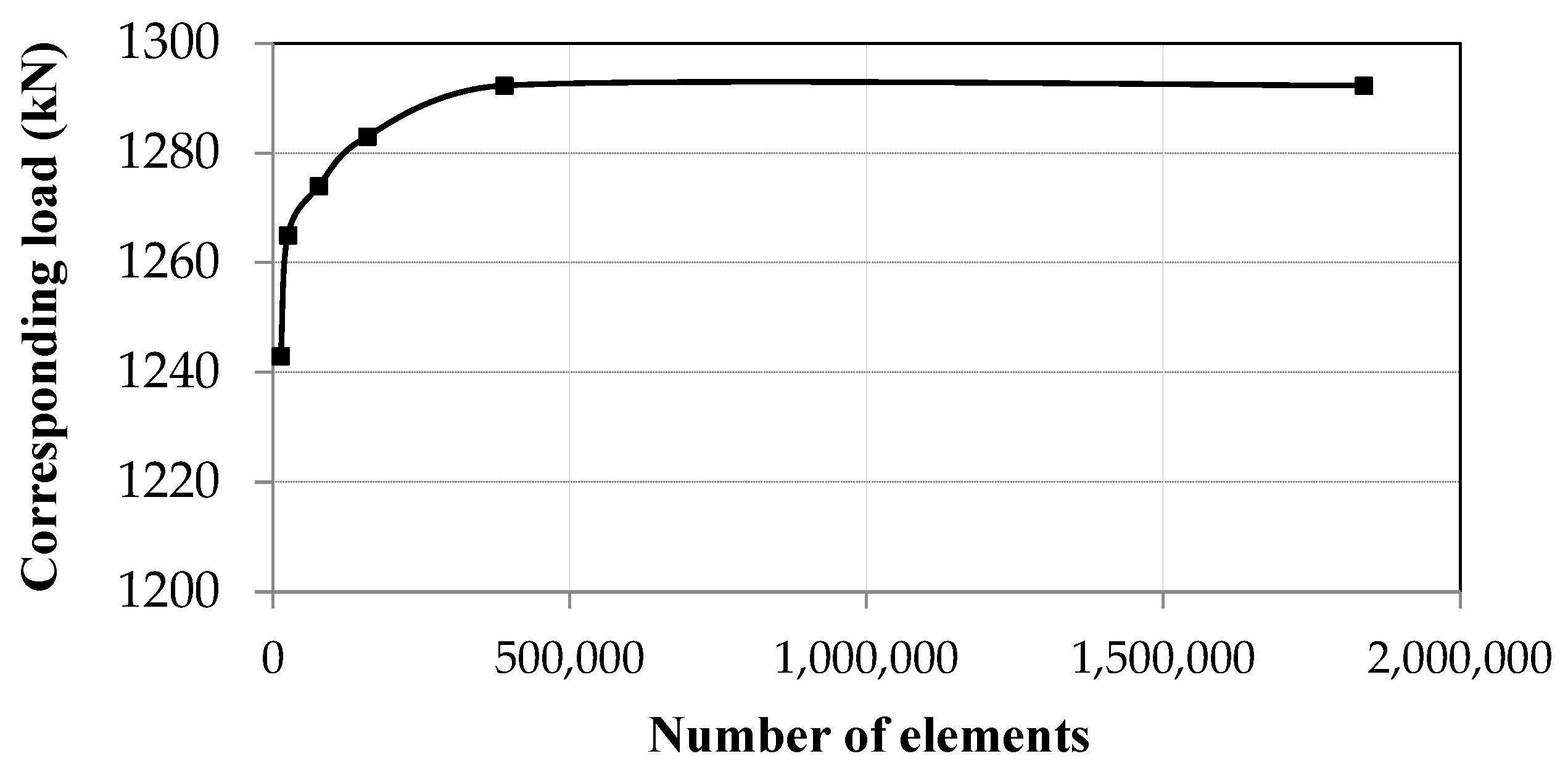
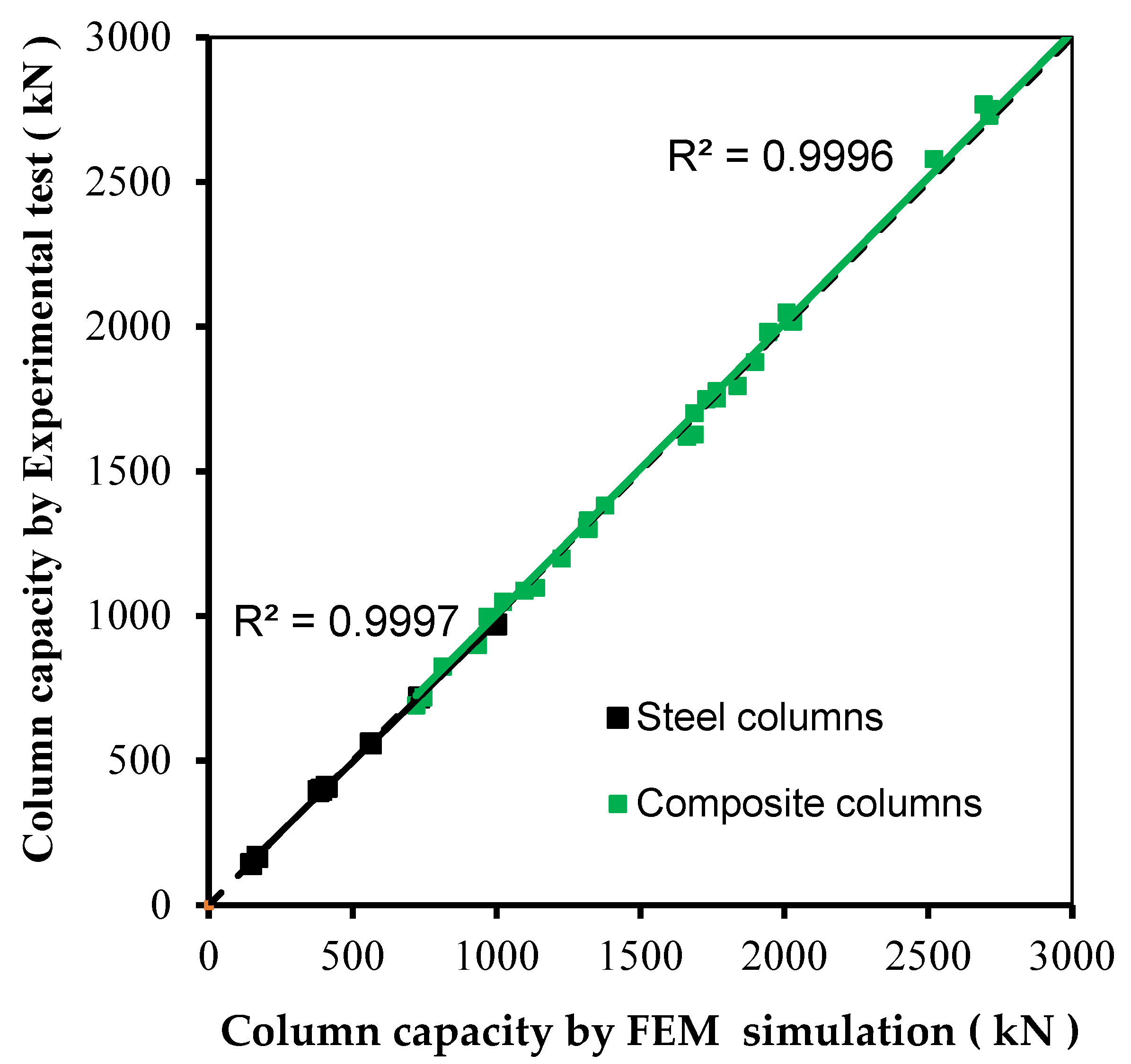

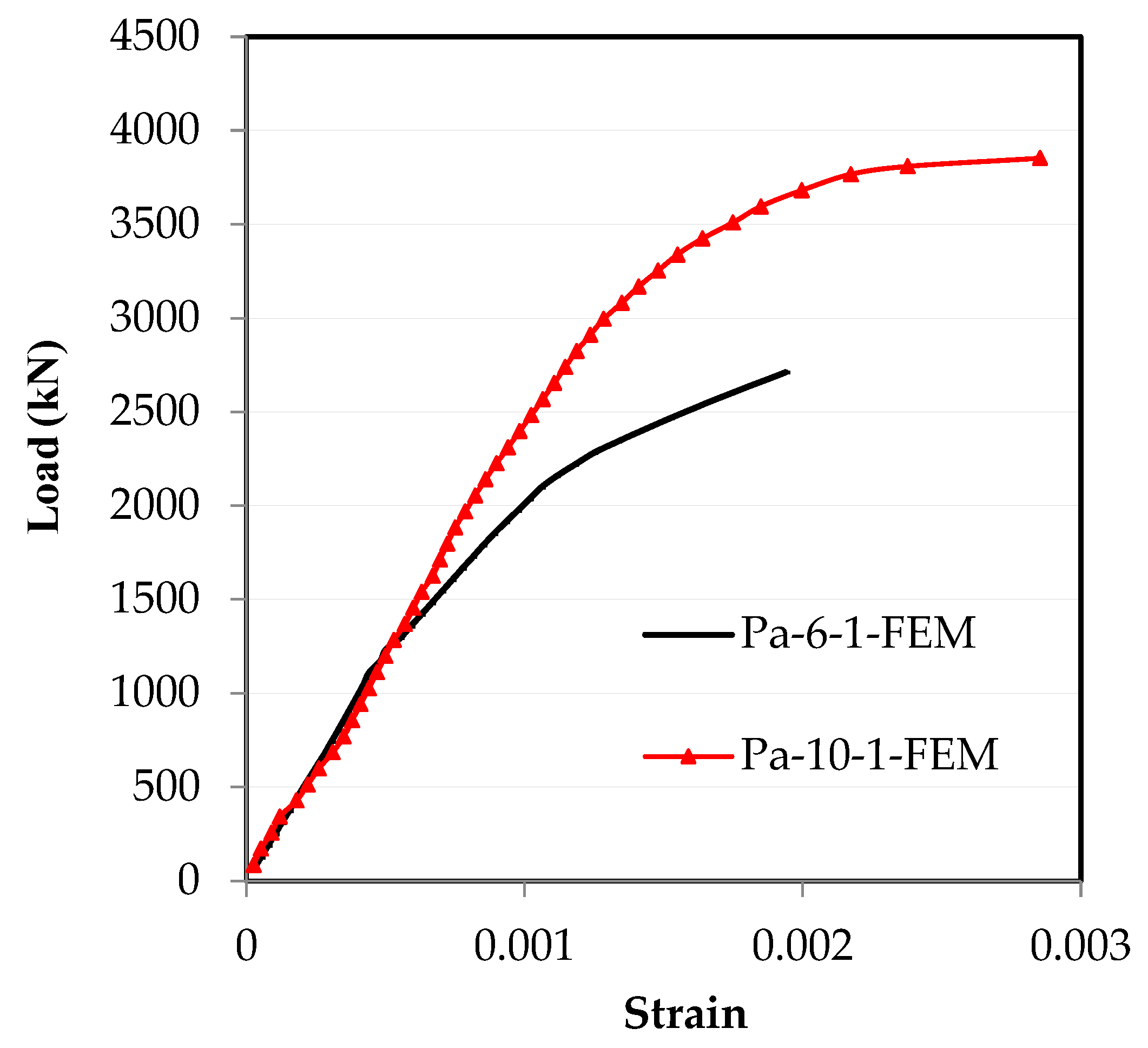
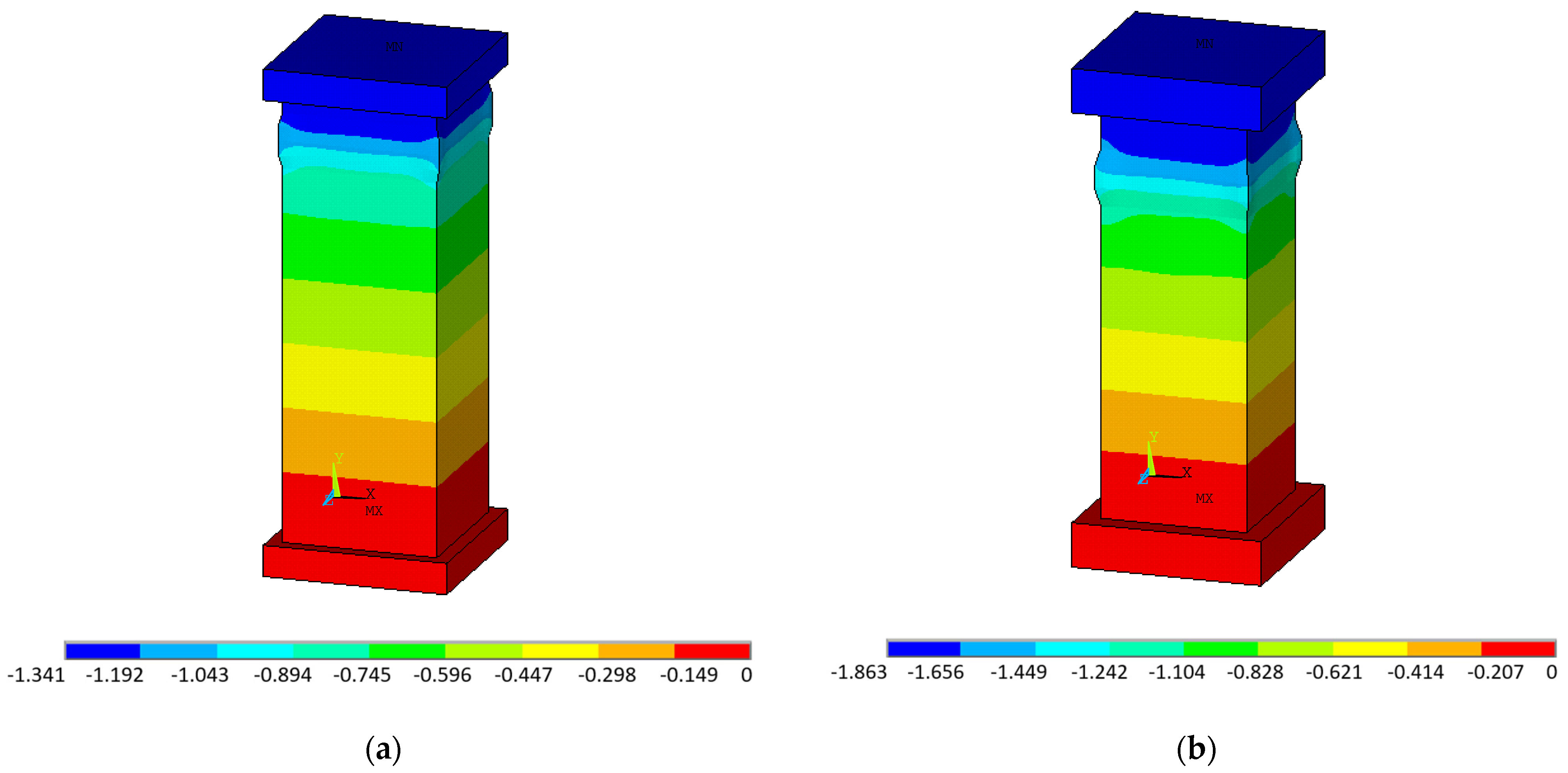
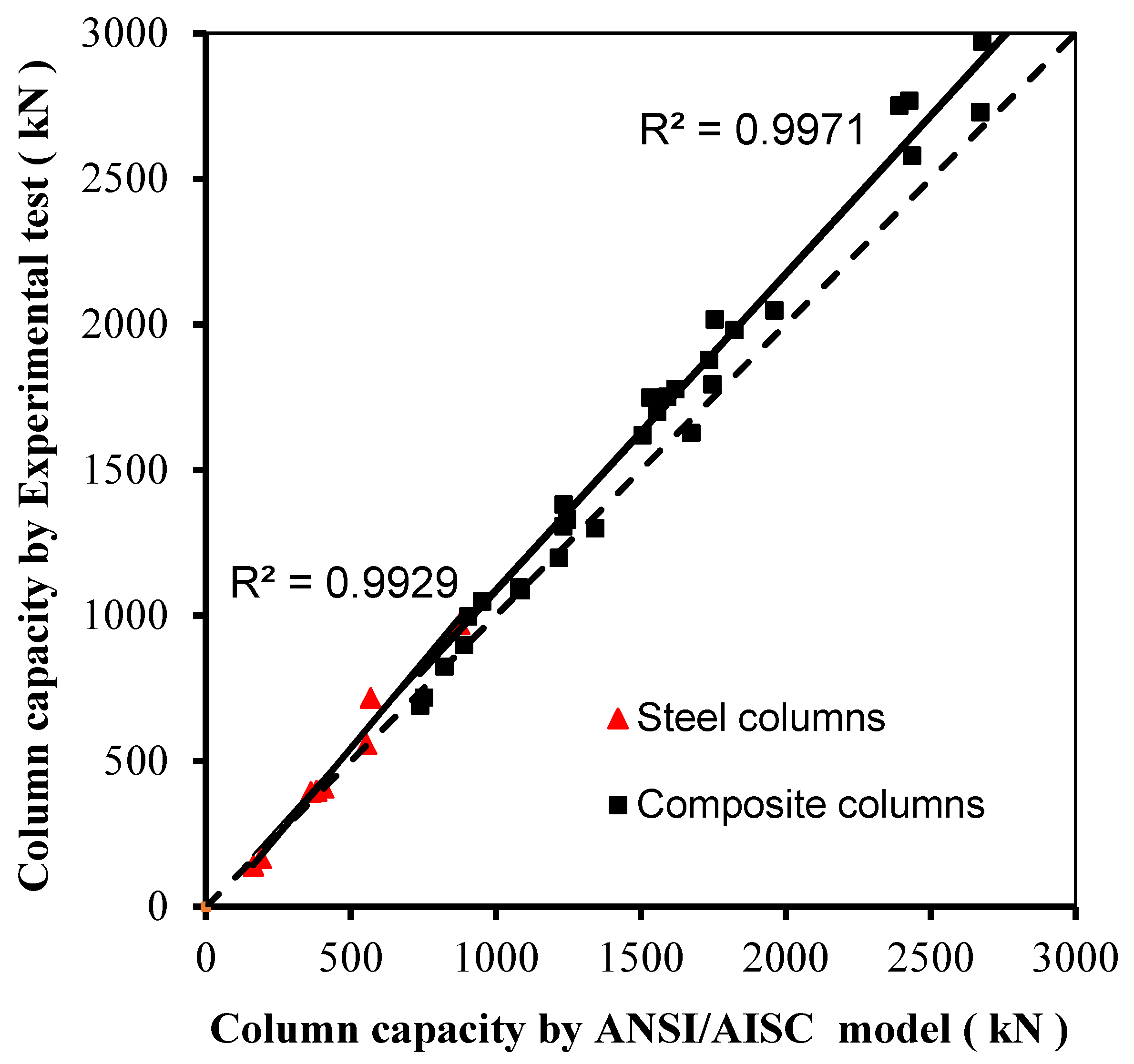
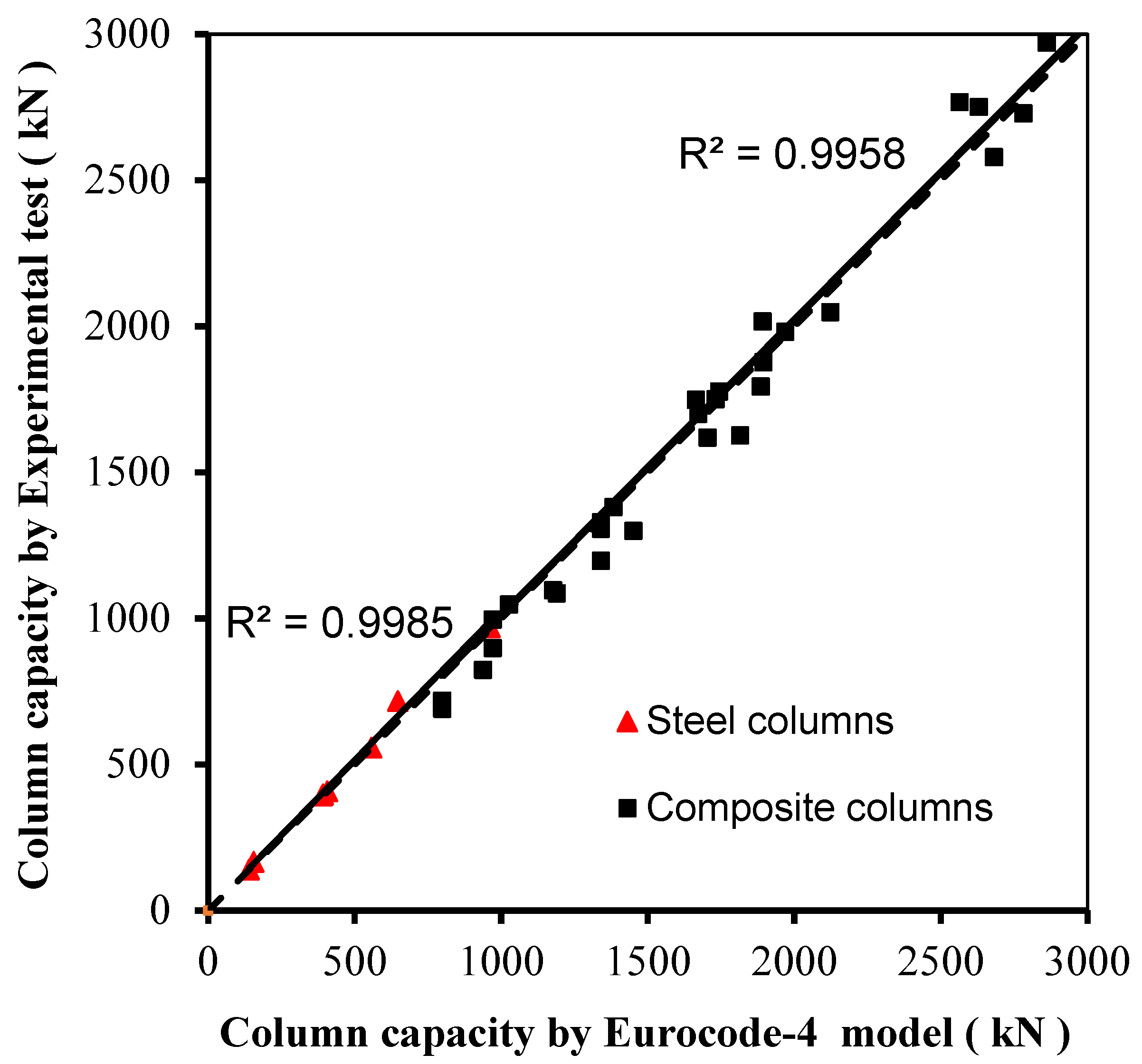
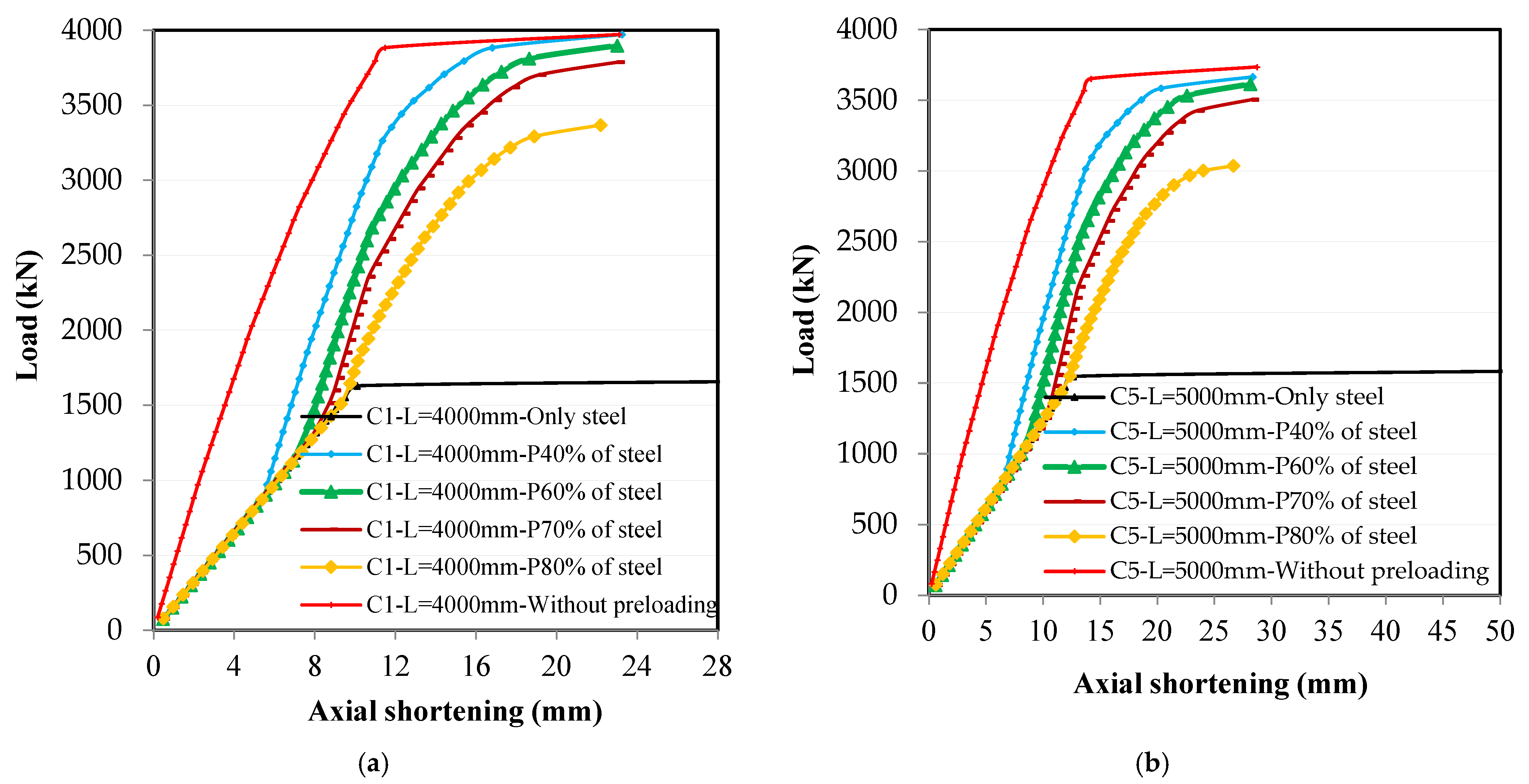
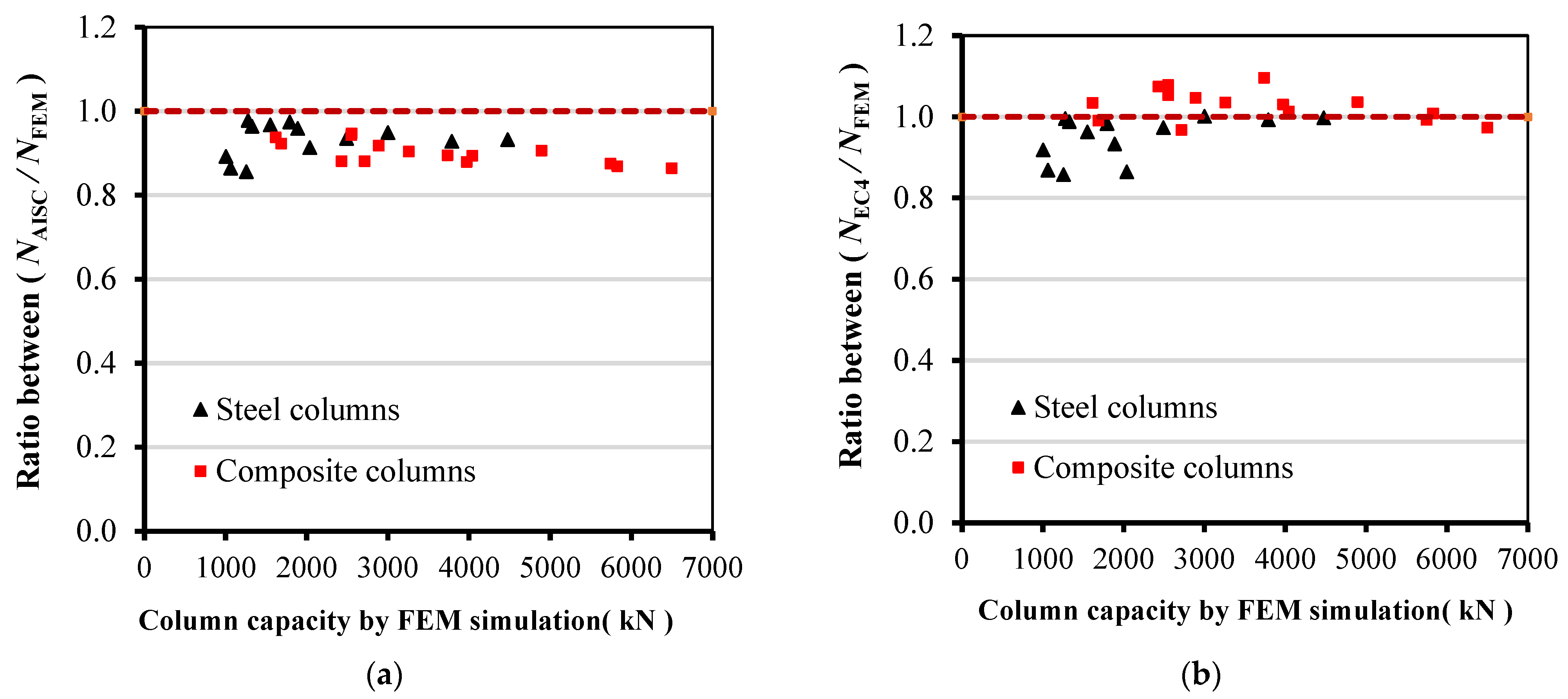
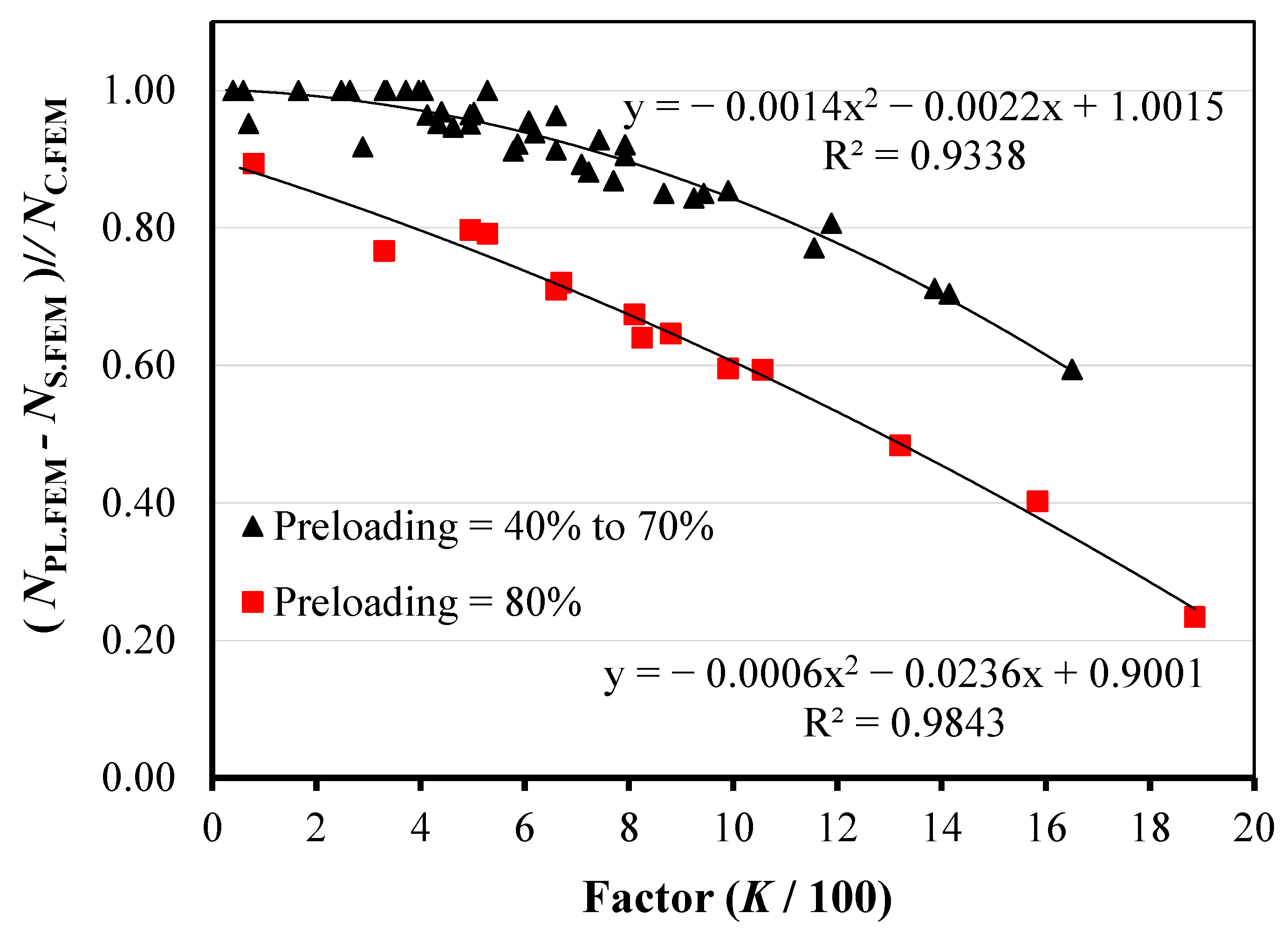
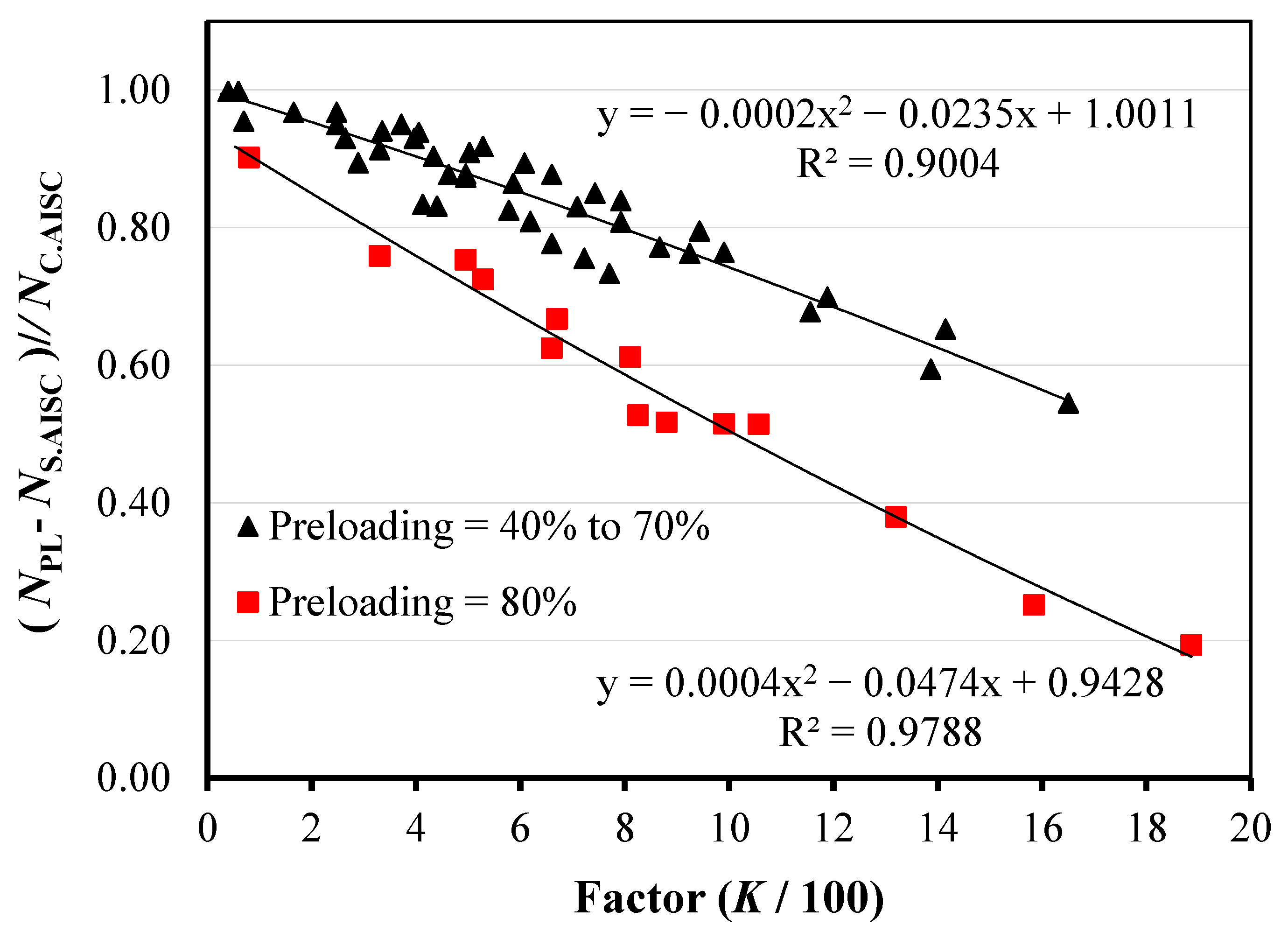
| Concrete Grade 25 | Concrete Grade 26.6 | Concrete Grade 28.8 | Concrete Grade 46.6 | Concrete Grade 60 | ||||||
|---|---|---|---|---|---|---|---|---|---|---|
| Stress (MPa) | Strain | Stress (MPa) | Strain | Stress (MPa) | Strain | Stress (MPa) | Strain | Stress (MPa) | Strain | |
| 7.50 | 0.00032 | 7.98 | 0.00033 | 8.64 | 0.00034 | 13.98 | 0.00044 | 18.00 | 0.00049 | |
| 19.25 | 0.0010 | 20.07 | 0.0010 | 21.16 | 0.0010 | 28.68 | 0.0010 | 33.34 | 0.0010 | |
| 23.55 | 0.0015 | 24.78 | 0.0015 | 26.43 | 0.0015 | 38.00 | 0.0015 | 45.24 | 0.0015 | |
| 24.95 | 0.0020 | 26.49 | 0.0020 | 28.55 | 0.0020 | 43.53 | 0.0020 | 53.22 | 0.0020 | |
| 25.00 | 0.0021 | 26.60 | 0.0022 | 28.80 | 0.0023 | 46.08 | 0.0025 | 57.78 | 0.0025 | |
| 25.00 | 0.0025 | 26.60 | 0.0025 | 28.80 | 0.0025 | 46.60 | 0.0029 | 59.74 | 0.0030 | |
| 25.00 | 0.0030 | 26.60 | 0.0030 | 28.80 | 0.0030 | 46.60 | 0.0035 | 60.00 | 0.0033 | |
| 60.00 | 0.0035 | |||||||||
| Ec (GPa) | 23.5 | 24.24 | 25.22 | 32.08 | 61.41 | |||||
| fr (MPa) | 3.12 | 3.21 | 3.34 | 4.25 | 4.83 | |||||
| Young and Liu [39] (R1L) | Young and Liu [39] (R2L) | Young and Liu [39] (R3L) | Young and Liu [39] (R4L) | Young and Ellobody [38] (SHS2) | ||||||
|---|---|---|---|---|---|---|---|---|---|---|
| Stress (MPa) | Strain | Stress (MPa) | Strain | Stress (MPa) | Strain | Stress (MPa) | Strain | Stress (MPa) | Strain | |
| 350 | 0.0018 | 424 | 0.0022 | 366 | 0.0019 | 443 | 0.0023 | 448 | 0.00224 | |
| 381 | 0.009 | 477 | 0.011 | 398 | 0.013 | 482 | 0.011 | 474 | 0.013 | |
| 412 | 0.05 | 512 | 0.058 | 447 | 0.056 | 508 | 0.052 | 504 | 0.047 | |
| 449 | 0.09 | 540 | 0.11 | 514 | 0.14 | 550 | 0.13 | 574 | 0.13 | |
| 536 | 0.21 | 604 | 0.23 | 577 | 0.26 | 608 | 0.27 | 637 | 0.22 | |
| 626 | 0.45 | 661 | 0.41 | 629 | 0.43 | 659 | 0.41 | 676 | 0.31 | |
| 646 | 0.63 | 675 | 0.55 | 647 | 0.53 | 676 | 0.51 | 695 | 0.42 | |
| 649 | 0.72 | 676 | 0.61 | 648 | 0.64 | 678 | 0.61 | 699 | 0.5 | |
| 625 | 0.74 | 634 | 0.64 | 622 | 0.66 | 642 | 0.63 | 641 | 0.51 | |
| 601 | 0.75 | 571 | 0.66 | 581 | 0.68 | 596 | 0.64 | 596 | 0.52 | |
| Es (GPa) | 198 | 194 | 193 | 194 | 200 | |||||
| FE Model Based on | Column Specimen | Steel Column Dimensions | fy (MPa) | Concrete f′c (MPa) | ||||
|---|---|---|---|---|---|---|---|---|
| a (mm) | b (mm) | t (mm) | L (mm) | a/b | ||||
| Liu [36] | R1-1 | 120 | 120 | 4.00 | 360 | 1.0 | 495 | 60.0 |
| R2-1 | 150 | 100 | 4.00 | 450 | 1.5 | 495 | 60.0 | |
| R3-2 | 180 | 90 | 4.00 | 540 | 2.0 | 495 | 60.0 | |
| R4-2 | 130 | 130 | 4.00 | 390 | 1.0 | 495 | 60.0 | |
| R5-1 | 160 | 110 | 4.00 | 480 | 1.5 | 495 | 60.0 | |
| R6-1 | 190 | 100 | 4.00 | 570 | 1.9 | 495 | 60.0 | |
| R7-1 | 106 | 106 | 4.00 | 320 | 1.0 | 495 | 89.0 | |
| R8-1 | 130 | 90 | 4.00 | 390 | 1.4 | 495 | 89.0 | |
| R9-2 | 160 | 80 | 4.00 | 480 | 2.0 | 495 | 89.0 | |
| R10-1 | 140 | 140 | 4.00 | 420 | 1.0 | 495 | 89.0 | |
| R11-1 | 160 | 125 | 4.00 | 480 | 1.3 | 495 | 89.0 | |
| Zhu et al. [14] | Pa-6-1 | 197 | 197 | 6.40 | 600 | 1.0 | 438 | 26.6 |
| Pa-10-1 | 201 | 201 | 10.10 | 600 | 1.0 | 382 | 26.6 | |
| Young and Ellobody [38] | SHS1C40 | 150.5 | 150.5 | 5.834 | 450 | 1.0 | 497 | 46.6 |
| SHS1C60 | 150.6 | 150.6 | 5.829 | 450 | 1.0 | 497 | 61.9 | |
| SHS2C0 | 150.5 | 150.5 | 2.796 | 600 | 1.0 | 448 | ---- | |
| SHS2C40 | 150.5 | 150.5 | 2.782 | 450 | 1.0 | 448 | 46.6 | |
| SHS2C60 | 150.5 | 150.5 | 2.780 | 450 | 1.0 | 448 | 61.9 | |
| RHS1C40 | 197.1 | 109.5 | 4.060 | 600 | 1.8 | 503 | 46.6 | |
| RHS3C0 | 140.0 | 78.8 | 3.075 | 600 | 1.8 | 486 | ---- | |
| RHS3C40 | 140.2 | 80.1 | 3.100 | 420 | 1.8 | 486 | 46.6 | |
| RHS3C60 | 140.2 | 80.1 | 3.100 | 420 | 1.8 | 486 | 61.9 | |
| Dundu [12] | S1-101/1 | 101.6 | 101.6 | 3.00 | 1000 | 1.0 | 484 | 25.0 |
| S1-101/1.5 | 101.6 | 101.6 | 3.00 | 1500 | 1.0 | 484 | 25.0 | |
| S1-120/1 | 120 | 120 | 3.50 | 1500 | 1.0 | 401 | 25.0 | |
| S1-120/2 | 120 | 120 | 3.50 | 2000 | 1.0 | 401 | 25.0 | |
| S1-150/1.5 | 150 | 150 | 3.50 | 1500 | 1.0 | 405 | 25.0 | |
| S1-150/2 | 150 | 150 | 3.50 | 2000 | 1.0 | 405 | 25.0 | |
| S1-150/2.5 | 150 | 150 | 3.50 | 2500 | 1.0 | 405 | 25.0 | |
| S3-120/2.7 | 120 | 120 | 3.00 | 2700 | 1.0 | 401 | 28.8 | |
| S3-150-3/2.7 | 150 | 150 | 3.00 | 2700 | 1.0 | 429 | 28.8 | |
| S3-150-4.5/2.7 | 150 | 150 | 4.50 | 2700 | 1.0 | 335 | 28.8 | |
| Young and Liu [39] | R1L1200 | 120.1 | 40 | 1.94 | 1199 | 3.0 | 350 | ---- |
| R1L2000 | 120.2 | 40 | 1.95 | 2000 | 3.0 | 350 | ---- | |
| R2L1200 | 119.7 | 39.9 | 5.31 | 1200 | 3.0 | 424 | ---- | |
| R3L1200 | 119.9 | 80.1 | 2.82 | 1200 | 1.5 | 366 | ---- | |
| R3L2000 | 120 | 80 | 2.80 | 2000 | 1.5 | 366 | ---- | |
| R4L2000 | 120.1 | 80.4 | 6.02 | 2000 | 1.5 | 443 | ---- | |
| FEM Specimen | Steel Column Dimensions | fy (MPa) | Concrete f′c (MPa) | ||||
|---|---|---|---|---|---|---|---|
| b (mm) | t (mm) | L (mm) | b/t | Compact limit | |||
| R1-1 | 120 | 4 | 360 | 30 | 46.1 | 495 | 60 |
| R1-L = 1500 | 120 | 4 | 1500 | 30 | 46.1 | 495 | 60 |
| C1 | 200 | 5 | 4000 | 40 | 46.1 | 495 | 60 |
| C2 | 150 | 5 | 4000 | 30 | 46.1 | 495 | 60 |
| C3 | 250 | 5 | 4000 | 50 | 46.1 | 495 | 60 |
| C4 | 200 | 5 | 3000 | 40 | 46.1 | 495 | 60 |
| C5 | 200 | 5 | 5000 | 40 | 46.1 | 495 | 60 |
| C6 | 200 | 8 | 4000 | 25 | 46.1 | 495 | 60 |
| C7 | 200 | 10 | 4000 | 20 | 46.1 | 495 | 60 |
| C8 | 200 | 12 | 4000 | 16.7 | 46.1 | 495 | 60 |
| C9 | 200 | 5 | 4000 | 40 | 46.1 | 495 | 21 |
| C10 | 200 | 5 | 4000 | 40 | 46.1 | 495 | 40 |
| C11 | 200 | 5 | 4000 | 40 | 55.3 | 334.8 | 40 |
| C12 | 200 | 5 | 4000 | 40 | 50.6 | 405 | 40 |
| FE Model Based on | Column Specimen | NExp (kN) | FEM Results | ANSI/AISC 360-22 | Eurocode 4 | |||
|---|---|---|---|---|---|---|---|---|
| NFEM (kN) | NFEM/NExp | NAISC (kN) | NAISC/NExp | NEC4 (kN) | NEC4/NExp | |||
| Liu [36] | R1-1 | 1701.0 | 1685.7 | 0.991 | 1555.9 | 0.915 | 1671.4 | 0.983 |
| R2-2 | 1778.0 | 1764.5 | 0.992 | 1618.9 | 0.911 | 1742.2 | 0.980 | |
| R3-2 | 1795.0 | 1836.3 | 1.023 | 1746.2 | 0.973 | 1883.8 | 1.049 | |
| R4-2 | 2018.0 | 2028.1 | 1.005 | 1754.1 | 0.869 | 1891.0 | 0.937 | |
| R5-1 | 1982.0 | 1942.4 | 0.980 | 1822.1 | 0.919 | 1967.8 | 0.993 | |
| R6-1 | 2049.0 | 2006.0 | 0.979 | 1959.7 | 0.956 | 2121.4 | 1.035 | |
| R7-1 | 1749.0 | 1728.0 | 0.988 | 1531.4 | 0.876 | 1662.6 | 0.951 | |
| R8-1 | 1752.0 | 1764.3 | 1.007 | 1590.3 | 0.908 | 1729.9 | 0.987 | |
| R9-1 | 1878.0 | 1896.8 | 1.010 | 1734.4 | 0.924 | 1892.7 | 1.008 | |
| R10-1 | 2752.0 | 2713.5 | 0.986 | 2390.5 | 0.869 | 2627.9 | 0.955 | |
| R11-1 | 2580.0 | 2518.1 | 0.976 | 2434.5 | 0.944 | 2679.7 | 1.039 | |
| Zhu et al. [14] | Pa-6-1 | 2730.0 | 2710.9 | 0.993 | 2669.5 | 0.978 | 2780.8 | 1.019 |
| Pa-10-1 | 3980.0 | 3852.6 | 0.968 | 3432.9 | 0.863 | 3539.8 | 0.889 | |
| Young and Ellobody [38] | SHS1C40 | 2768.1 | 2690.6 | 0.972 | 2424.1 | 0.876 | 2562.8 | 0.926 |
| SHS1C60 | 2972.0 | 3037.4 | 1.022 | 2675.9 | 0.900 | 2859.8 | 0.962 | |
| SHS2C40 | 1381.5 | 1376.0 | 0.996 | 1233.3 | 0.893 | 1381.9 | 1.000 | |
| SHS2C60 | 1620.0 | 1660.5 | 1.025 | 1505.3 | 0.929 | 1702.7 | 1.051 | |
| RHS1C40 | 1627.2 | 1685.9 | 1.036 | 1672.7 | 1.028 | 1813.8 | 1.115 | |
| RHS3C40 | 1048.7 | 1021.4 | 0.974 | 951.9 | 0.908 | 1024.9 | 0.977 | |
| RHS3C60 | 1096.9 | 1135.3 | 1.035 | 1079.2 | 0.984 | 1175.8 | 1.072 | |
| Dundu [12] | S1-101/1 | 718.9 | 745.5 | 1.037 | 751.7 | 1.046 | 797.1 | 1.109 |
| S1-101/1.5 | 691.2 | 720.3 | 1.042 | 738.1 | 1.068 | 797.1 | 1.153 | |
| S1-120/1 | 997.2 | 968.3 | 0.971 | 903.5 | 0.906 | 970.1 | 0.973 | |
| S1-120/2 | 899.7 | 933.8 | 1.038 | 889.2 | 0.988 | 970.1 | 1.078 | |
| S1-150/1.5 | 1330.1 | 1316.8 | 0.990 | 1245.0 | 0.936 | 1338.6 | 1.006 | |
| S1-150/2 | 1307.6 | 1312.8 | 1.004 | 1232.0 | 0.942 | 1338.6 | 1.024 | |
| S1-150/2.5 | 1198.3 | 1224.6 | 1.004 | 1215.4 | 1.014 | 1338.6 | 1.117 | |
| S3-120/2.7 | 825.2 | 812.0 | 0.984 | 821.4 | 0.995 | 937.0 | 1.136 | |
| S3-150-3/2.7 | 1087.1 | 1095.8 | 1.008 | 1085.6 | 0.999 | 1187.9 | 1.093 | |
| S3-150-4.5/2.7 | 1300.4 | 1292.3 | 0.994 | 1342.6 | 1.032 | 1449.4 | 1.115 | |
| Average ratio | 1.022 | 0.945 | 1.024 | |||||
| COV | 2.25% | 5.74% | 6.81% | |||||
| r | 0.999 | 0.998 | 0.998 | |||||
| FE Model Based on | Column Specimen | NExp (kN) | FEM Results | ANSI/AISC 360-22 | Eurocode 4 | |||
|---|---|---|---|---|---|---|---|---|
| NFEM (kN) | NFEM/NExp | NAISC (kN) | NAISC/NExp | NEC4 (kN) | NEC4/NExp | |||
| Young and Ellobody [38] | SHS2C0 | 408.6 | 409.8 | 1.003 | 405.2 | 0.992 | 405.8 | 0.993 |
| RHS3C0 | 558.2 | 563.2 | 1.009 | 552.9 | 0.991 | 557.0 | 0.998 | |
| Young and Liu [39] | R1L1200 | 167.0 | 169.0 | 0.988 | 189.6 | 1.135 | 154.4 | 0.925 |
| R1L2000 | 141.3 | 147.0 | 1.040 | 162.9 | 1.153 | 139.4 | 0.986 | |
| R2L1200 | 717.4 | 730.3 | 1.018 | 567.6 | 0.791 | 646.6 | 0.901 | |
| R3L1200 | 398.3 | 390.7 | 0.981 | 381.1 | 0.957 | 391.3 | 0.982 | |
| R3L2000 | 394.0 | 382.2 | 0.970 | 361.4 | 0.917 | 389.1 | 0.987 | |
| R4L2000 | 970.4 | 998.5 | 1.029 | 873.6 | 0.900 | 960.9 | 0.990 | |
| Average ratio | 1.005 | 0.980 | 0.970 | |||||
| COV | 2.41% | 12.00% | 3.62% | |||||
| r | 0.999 | 0.996 | 0.999 | |||||
| FEM Specimen | % Preloadingof Steel | FEM Results | ANSI/AISC 360-22 | Eurocode 4 | |||||
|---|---|---|---|---|---|---|---|---|---|
| NFEM (kN) | NPL/NUf | NC (kN) | NCPL/NC | NAISC (kN) | NAISC/NFEM | NEC4 (kN) | NEC4/NFEM | ||
| R1-1-Without preloading | 0 | 1685.7 | 1.000 | 623.8 | 1.000 | 1555.9 | 0.923 | 1671.4 | 0.991 |
| R1-1-P40% | 40 | 1685.7 | 1.000 | 623.8 | 1.000 | 1555.9 | 0.923 | 1671.4 | 0.991 |
| R1-1-P60% | 60 | 1685.7 | 1.000 | 623.8 | 1.000 | 1555.9 | 0.923 | 1671.4 | 0.991 |
| R1-1-P70% | 70 | 1655.5 | 0.982 | 593.6 | 0.952 | 1555.9 | 0.940 | 1671.4 | 1.010 |
| R1-1-P80% | 80 | 1619.2 | 0.961 | 557.3 | 0.893 | 1555.9 | 0.961 | 1671.4 | 1.032 |
| R1-1-Only steel | --- | 1061.9 | --- | --- | --- | 917.4 | 0.864 | 922.8 | 0.869 |
| R1-L = 1500-Without preloading | 0 | 1614.2 | 1.000 | 610.2 | 1.000 | 1514.7 | 0.938 | 1671.4 | 1.035 |
| R1-L = 1500-P40% | 40 | 1614.2 | 1.000 | 610.2 | 1.000 | 1514.7 | 0.938 | 1671.4 | 1.035 |
| R1-L = 1500-P60% | 60 | 1614.2 | 1.000 | 610.2 | 1.000 | 1514.7 | 0.938 | 1671.4 | 1.035 |
| R1-L = 1500-P70% | 70 | 1564.0 | 0.969 | 560.0 | 0.918 | 1514.7 | 0.968 | 1671.4 | 1.069 |
| R1-L = 1500-P80% | 80 | 1471.8 | 0.912 | 467.8 | 0.767 | 1514.7 | 1.029 | 1671.4 | 1.136 |
| R1-L = 1500-Only steel | --- | 1004.0 | --- | --- | --- | 895.6 | 0.892 | 922.8 | 0.919 |
| C1-Without preloading | 0 | 3971.5 | 1.000 | 2084.3 | 1.000 | 3491.5 | 0.879 | 4096.5 | 1.031 |
| C1-P40% | 40 | 3971.5 | 1.000 | 2084.3 | 1.000 | 3491.5 | 0.879 | 4096.5 | 1.031 |
| C1-P60% | 60 | 3898.1 | 0.982 | 2010.9 | 0.965 | 3491.5 | 0.896 | 4096.5 | 1.051 |
| C1-P70% | 70 | 3787.6 | 0.954 | 1900.4 | 0.912 | 3491.5 | 0.922 | 4096.5 | 1.082 |
| C1-P80% | 80 | 3367.7 | 0.848 | 1480.5 | 0.710 | 3491.5 | 1.037 | 4096.5 | 1.216 |
| C1-Only steel | --- | 1887.2 | --- | --- | --- | 1810.2 | 0.959 | 1762.6 | 0.934 |
| C2-Without preloading | 0 | 2428.5 | 1.000 | 1103.5 | 1.000 | 2138.8 | 0.881 | 2611.5 | 1.075 |
| C2-P40% | 40 | 2394.3 | 0.986 | 1069.2 | 0.969 | 2138.8 | 0.893 | 2611.5 | 1.091 |
| C2-P60% | 60 | 2332.9 | 0.961 | 1007.8 | 0.913 | 2138.8 | 0.917 | 2611.5 | 1.119 |
| C2-P70% | 70 | 2283.5 | 0.940 | 958.4 | 0.869 | 2138.8 | 0.937 | 2611.5 | 1.144 |
| C2-P80% | 80 | 2038.0 | 0.840 | 712.9 | 0.646 | 2138.8 | 1.049 | 2611.5 | 1.281 |
| C2-Only steel | --- | 1325.1 | --- | --- | --- | 1277.9 | 0.964 | 1310.5 | 0.989 |
| C3-Without preloading | 0 | 5826.4 | 1.000 | 3335.4 | 1.000 | 5060.5 | 0.869 | 5881.5 | 1.009 |
| C3-P40% | 40 | 5826.4 | 1.000 | 3335.4 | 1.000 | 5060.5 | 0.869 | 5881.5 | 1.009 |
| C3-P60% | 60 | 5826.4 | 1.000 | 3335.4 | 1.000 | 5060.5 | 0.869 | 5881.5 | 1.009 |
| C3-P70% | 70 | 5648.7 | 0.970 | 3157.7 | 0.947 | 5060.5 | 0.896 | 5881.5 | 1.041 |
| C3-P80% | 80 | 5131.8 | 0.881 | 2640.8 | 0.792 | 5060.5 | 0.986 | 5881.5 | 1.146 |
| C3-Only steel | --- | 2491.0 | --- | --- | --- | 2328.6 | 0.935 | 2425.5 | 0.974 |
| C4-Without preloading | 0 | 4041.1 | 1.000 | 2002.9 | 1.000 | 3611.4 | 0.894 | 4096.5 | 1.014 |
| C4-P40% | 40 | 4041.1 | 1.000 | 2002.9 | 1.000 | 3611.4 | 0.894 | 4096.5 | 1.014 |
| C4-P60% | 60 | 4041.1 | 1.000 | 2002.9 | 1.000 | 3611.4 | 0.894 | 4096.5 | 1.014 |
| C4-P70% | 70 | 3945.1 | 0.976 | 1906.9 | 0.952 | 3611.4 | 0.915 | 4096.5 | 1.038 |
| C4-P80% | 80 | 3635.0 | 0.900 | 1597.8 | 0.798 | 3611.4 | 0.993 | 4096.5 | 1.127 |
| C4-Only steel | --- | 2038.2 | --- | --- | --- | 1861.9 | 0.913 | 1762.6 | 0.865 |
| C5-Without preloading | 0 | 3735.5 | 1.000 | 1943.8 | 1.000 | 3343.1 | 0.895 | 4096.5 | 1.097 |
| C5-P40% | 40 | 3666.1 | 0.981 | 1874.4 | 0.964 | 3343.1 | 0.912 | 4096.5 | 1.117 |
| C5-P60% | 60 | 3615.2 | 0.968 | 1823.5 | 0.938 | 3343.1 | 0.925 | 4096.5 | 1.133 |
| C5-P70% | 70 | 3504.8 | 0.938 | 1713.1 | 0.881 | 3343.1 | 0.954 | 4096.5 | 1.169 |
| C5-P80% | 80 | 3036.1 | 0.813 | 1244.4 | 0.640 | 3343.1 | 1.101 | 4096.5 | 1.349 |
| C5-Only steel | --- | 1791.7 | --- | --- | --- | 1745.9 | 0.974 | 1762.6 | 0.984 |
| C6-Without preloading | 0 | 4891.8 | 1.000 | 1892.2 | 1.000 | 4431.6 | 0.906 | 5072.6 | 1.037 |
| C6-P40% | 40 | 4891.8 | 1.000 | 1892.2 | 1.000 | 4431.6 | 0.906 | 5072.6 | 1.037 |
| C6-P60% | 60 | 4742.0 | 0.969 | 1742.4 | 0.921 | 4431.6 | 0.935 | 5072.6 | 1.070 |
| C6-P70% | 70 | 4596.1 | 0.940 | 1596.5 | 0.844 | 4431.6 | 0.964 | 5072.6 | 1.104 |
| C6-P80% | 80 | 4122.8 | 0.843 | 1123.2 | 0.594 | 4431.6 | 1.075 | 5072.6 | 1.230 |
| C6-Only steel | --- | 2999.6 | --- | --- | --- | 2846.6 | 0.949 | 3005.6 | 1.002 |
| C7-Without preloading | 0 | 5745.3 | 1.000 | 1957.2 | 1.000 | 5029.0 | 0.875 | 5706.0 | 0.993 |
| C7-P40% | 40 | 5673.4 | 0.987 | 1885.4 | 0.963 | 5029.0 | 0.886 | 5706.0 | 1.006 |
| C7-P60% | 60 | 5459.4 | 0.950 | 1671.4 | 0.854 | 5029.0 | 0.921 | 5706.0 | 1.045 |
| C7-P70% | 70 | 5297.1 | 0.922 | 1509.0 | 0.771 | 5029.0 | 0.949 | 5706.0 | 1.077 |
| C7-P80% | 80 | 4733.9 | 0.824 | 945.8 | 0.483 | 5029.0 | 1.062 | 5706.0 | 1.205 |
| C7-Only steel | --- | 3788.1 | --- | --- | --- | 3516.4 | 0.928 | 3762.0 | 0.993 |
| C8-Without preloading | 0 | 6497.5 | 1.000 | 2022.3 | 1.000 | 5611.4 | 0.864 | 6325.4 | 0.974 |
| C8-P40% | 40 | 6306.2 | 0.971 | 1831.0 | 0.905 | 5611.4 | 0.890 | 6325.4 | 1.003 |
| C8-P60% | 60 | 6107.2 | 0.940 | 1632.0 | 0.807 | 5611.4 | 0.919 | 6325.4 | 1.036 |
| C8-P70% | 70 | 5914.9 | 0.910 | 1439.7 | 0.712 | 5611.4 | 0.949 | 6325.4 | 1.069 |
| C8-P80% | 80 | 5288.4 | 0.814 | 813.2 | 0.402 | 5611.4 | 1.061 | 6325.4 | 1.196 |
| C8-Only steel | --- | 4475.2 | --- | --- | --- | 4169.4 | 0.932 | 4466.9 | 0.998 |
| C9-Without preloading | 0 | 2551.5 | 1.000 | 664.3 | 1.000 | 2417.1 | 0.947 | 2688.6 | 1.054 |
| C9-P40% | 40 | 2451.8 | 0.961 | 564.6 | 0.850 | 2417.1 | 0.986 | 2688.6 | 1.097 |
| C9-P60% | 60 | 2355.0 | 0.923 | 467.8 | 0.703 | 2417.1 | 1.026 | 2688.6 | 1.142 |
| C9-P70% | 70 | 2281.9 | 0.894 | 394.7 | 0.594 | 2417.1 | 1.059 | 2688.6 | 1.178 |
| C9-P80% | 80 | 2042.6 | 0.801 | 155.4 | 0.234 | 2417.1 | 1.183 | 2688.6 | 1.316 |
| C9-Only steel | --- | 1887.2 | --- | --- | --- | 1810.2 | 0.959 | 1762.6 | 0.934 |
| C10-Without preloading | 0 | 3255.8 | 1.000 | 1368.6 | 1.000 | 2942.8 | 0.904 | 3374.5 | 1.036 |
| C10-P40% | 40 | 3188.9 | 0.979 | 1301.7 | 0.951 | 2942.8 | 0.923 | 3374.5 | 1.058 |
| C10-P60% | 60 | 3157.8 | 0.970 | 1270.6 | 0.928 | 2942.8 | 0.932 | 3374.5 | 1.069 |
| C10-P70% | 70 | 3050.9 | 0.937 | 1163.6 | 0.850 | 2942.8 | 0.965 | 3374.5 | 1.106 |
| C10-P80% | 80 | 2702.0 | 0.830 | 814.8 | 0.595 | 2942.8 | 1.089 | 3374.5 | 1.249 |
| C10-Only steel | --- | 1887.2 | --- | --- | --- | 1810.2 | 0.959 | 1762.6 | 0.934 |
| C11-Without preloading | 0 | 2548.1 | 1.000 | 1270.9 | 1.000 | 2403.1 | 0.943 | 2749.7 | 1.079 |
| C11-P40% | 40 | 2548.1 | 1.000 | 1270.9 | 1.000 | 2403.1 | 0.943 | 2749.7 | 1.079 |
| C11-P60% | 60 | 2507.3 | 0.984 | 1230.1 | 0.968 | 2403.1 | 0.958 | 2749.7 | 1.097 |
| C11-P70% | 70 | 2448.8 | 0.961 | 1171.6 | 0.922 | 2403.1 | 0.981 | 2749.7 | 1.123 |
| C11-P80% | 80 | 2192.8 | 0.861 | 915.5 | 0.720 | 2403.1 | 1.096 | 2749.7 | 1.254 |
| C11-Only steel | --- | 1277.2 | --- | --- | --- | 1248.7 | 0.978 | 1272.6 | 0.996 |
| C12-Without preloading | 0 | 2886.5 | 1.000 | 1336.8 | 1.000 | 2649.2 | 0.918 | 3023.5 | 1.047 |
| C12-P40% | 40 | 2886.5 | 1.000 | 1336.8 | 1.000 | 2649.2 | 0.918 | 3023.5 | 1.047 |
| C12-P60% | 60 | 2827.2 | 0.979 | 1277.9 | 0.956 | 2649.2 | 0.937 | 3023.5 | 1.069 |
| C12-P70% | 70 | 2742.5 | 0.950 | 1193.2 | 0.893 | 2649.2 | 0.966 | 3023.5 | 1.102 |
| C12-P80% | 80 | 2450.4 | 0.849 | 901.1 | 0.674 | 2649.2 | 1.081 | 3023.5 | 1.234 |
| C12-Only steel | --- | 1549.3 | --- | --- | --- | 1497.6 | 0.967 | 1491.4 | 0.963 |
Disclaimer/Publisher’s Note: The statements, opinions and data contained in all publications are solely those of the individual author(s) and contributor(s) and not of MDPI and/or the editor(s). MDPI and/or the editor(s) disclaim responsibility for any injury to people or property resulting from any ideas, methods, instructions or products referred to in the content. |
© 2024 by the author. Licensee MDPI, Basel, Switzerland. This article is an open access article distributed under the terms and conditions of the Creative Commons Attribution (CC BY) license (https://creativecommons.org/licenses/by/4.0/).
Share and Cite
Sayed, A.M. Effect of Preload on Box-Section Steel Columns Filled with Concrete under Axial Load: A Numerical Study. Buildings 2024, 14, 2924. https://doi.org/10.3390/buildings14092924
Sayed AM. Effect of Preload on Box-Section Steel Columns Filled with Concrete under Axial Load: A Numerical Study. Buildings. 2024; 14(9):2924. https://doi.org/10.3390/buildings14092924
Chicago/Turabian StyleSayed, Ahmed Mohamed. 2024. "Effect of Preload on Box-Section Steel Columns Filled with Concrete under Axial Load: A Numerical Study" Buildings 14, no. 9: 2924. https://doi.org/10.3390/buildings14092924





